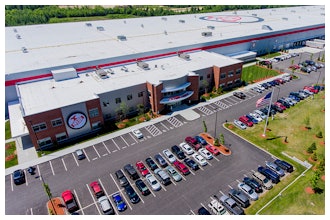Just as we learn to look for the “hidden factory" or unofficial process steps when we seek to improve a production process, we should look for business-level problems that hide from our usual view.
Have you ever had a leader give you advice to not cause trouble and to, instead, try to keep your activities “below the radar?” We don’t see this advice crop up much in small business. In small groups it’s hard to remain unnoticed. However, in large organizations, the advice to avoid attention is not uncommon.
When we are driving for cultural change and business performance improvement, we provoke initiatives, set metrics, track behavior and keep vigilant. Invariably, our vigilance takes on a pattern, which others will recognize and sometimes exploit. Sometimes people use our patterns of behavior, our “hot buttons” to get noticed.
Sometimes, people use them to avoid notice.
It can be important to occasionally glance “below the radar” and look for those hidden activities that we do not easily see. Obviously, there may be things going on that either deliberately or accidentally undermines our mission, but that is really only one reason to look. The other reason, and sometimes the more important, is because someone is dealing with a real problem that should be solved, and we aren’t aware of it.
To take a look below the radar, consider two approaches. First, consider in what arenas you have been focused lately, then go take a good look at those areas where you have not been focused. There is a good chance that while your attention was elsewhere, things have come up that others are either generating or with which they are dealing, or struggling.
Second, get out and look for yourself. Just like “hidden factory” process steps can’t be identified without directly observing them, neither can “under the radar” activities. Go observe how people are working. Ask them what their problems, challenges, or pains are. Smell out those processes and agendas that seem to be misfits.
When you find one, deal with it in a very careful way. I cannot emphasize this enough. We absolutely must adopt a very important behavior when we investigate a hidden problem. We must seek to understand it first, before taking any action or making any judgment.
There are two reasons that people work deliberately discretely.
They know that if you find out you will interfere.
They fear that if you find out you will interfere.
We do not want to re-enforce either belief, unless those individuals are indeed actively, deliberately undermining our objectives. Fortunately, such is very rarely the case. Even when it is, it can be important to understand why.
Let’s play out a few scenarios to make hypothetical, but probable examples. This will help me make the point for why we must understand why people are operating outside of our normal view.
Suppose worst case; a group of people is deliberately working against your program and your objectives. No, we don’t want that, and we can’t tolerate it. We must put a stop to it. Before we act, though, we should answer the following question. Does this group of people have a good reason for doing so?
It may be that our plan has not considered a very important element. Maybe we failed to address a very significant and urgent problem and we need to do so or our long-term plans will fail. Possibly we simply failed to communicate how our plans will positively affect the group in question. In other words, to sum up many possibilities, maybe they know something we don’t.
It may be that the right way to remove resistance is to remove the resistance leaders. But, it may also be right to remove the reason for the resistance instead.
Suppose best case; a group is working on solving their own issues, on their own initiative, they are capable of doing so, and the reason that they didn’t make a big deal about it is because they don’t need help and didn’t think it was important to distract us. Nothing untoward is going on, it’s just a group doing its part to make performance the best possible. If we find this, we should reward it and try to propagate it.
Suppose that the activity going on isn’t bad, per say, it’s just not what you asked for. The resources aren’t doing what you need or expect; they are doing something else. Again, this may be because they know something that we don’t. It’s possible that they are doing the right thing. Certainly, at least they believe they are. If we can understand these needs and address them, we gain support rather than resistance.
If a group is working priorities other than ours, it can be important to understand those priorities. Are they personal, meaning they want to solve the problem for their own gains? Did they not get a clear communication of priorities from higher levels? Are they working too many things at once and need better decision-making or direction?
A group can be working other priorities because they are important to the group, without necessarily intentionally undermining our objectives. This happens when the group perceives that their problem is more important than yours. They hide their activities instead of announcing them when they believe that we will dictate different priorities without solving their problem, thus making ourselves more important than them.
That can be a difficult conundrum. We can’t have every group’s urgent issue distract our program from making progress and improving the business. However, if we don’t address peoples’ needs, we don’t win confidence and may be leaving real problems unaddressed.
The best way to deal with these challenges, in my opinion, is not a simple decision, but a cultural behavior. These problems solve themselves when everyone in the business is encouraged and empowered to continuously improve their own processes, without permission or red tape from above. When this is the behavior, significant problems tend to get solved real-time and aren’t stealing resources, per se, from our greater initiatives.
If we don’t have that culture installed, then we need to make a leadership decision. Enable the group to solve their problem, which may very well change people’s beliefs about needing to hide their activities, or explain why your initiative must be a larger priority and demand cooperation. It can be a tough call.
If people are addressing a real problem, but not telling us, it may be because they don’t believe that we will understand the problem, or that we will not help them fix the problem, or that our solution to their problem will not be satisfactory, or that we will just slow them down, or that we will otherwise make it difficult. In short, they do not have confidence in our ability or willingness to help.
When this is the case, it is an opportunity to change that belief. We absolutely must come to understand the problem. Then we can either decide that they should solve it themselves, or we should help them. We should help them if it is certain that our contribution will be helpful and not a hindrance. If we can’t do that, we should understand that and why, and we should address our own shortcomings.
Perhaps the most common reason why people are working discretely is also the most unfortunate. That means that it is also the most important reason for us to understand the truth of the “moles’” motives. The reason to which I refer is because they simply do not understand or accept our initiative or our methods. This is usually a failing on our part.
We must remedy this shortcoming of opaque vision. If we try to press on, we will fail because we have not clearly communicated our vision. If the problem is not inadequate communication, then it may be that our vision lacks planning or fails to address important criteria. If this is so, we must remedy that before we can succeed.
There are many scenarios we can discuss, but my point is this. In almost every case, it is to our benefit if we can bypass our initial anger or frustration to discover secret and tangent or obtrusive activity and come to understand the reason it is taking place. If we can fix the reason, whether it is leadership, process problems, communication faults, or conflict of interest, we probably solve a significant problem inside of our organization.
Not every problem is a process problem. Not every disagreement is a sign of disloyalty. Things going on “below the radar” are signals of significant challenges that should be addressed. Make a practice of looking into realms where you do not normally peer. Find the hidden issues. Understand their cause, and address the cause; by doing so, you can remove much resistance and significantly improve performance, or find important opportunities to make positive impacts.
Stay wise, friends.
If you like what you just read, find more of Alan’s thoughts at www.bizwizwithin.com.






















